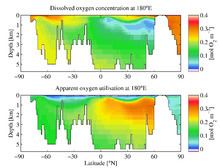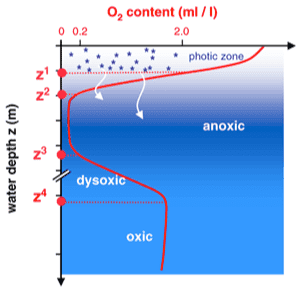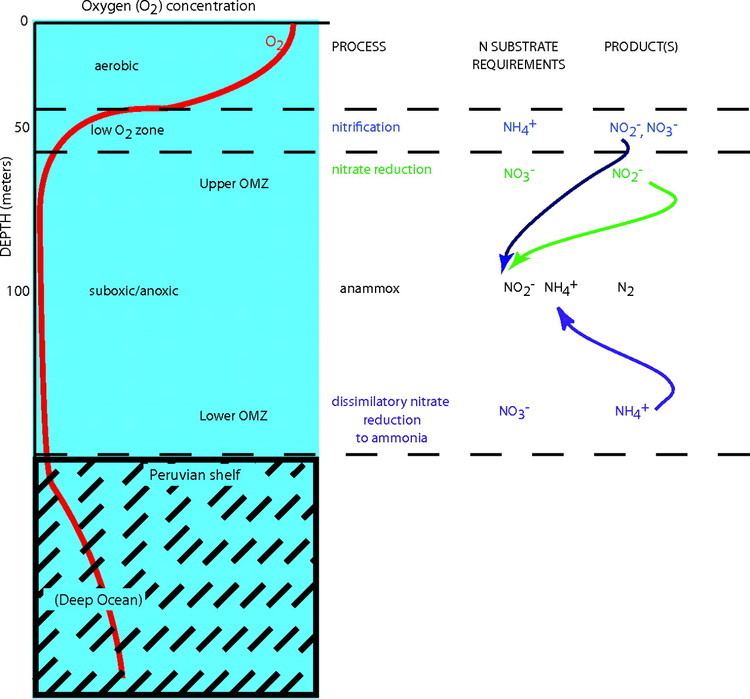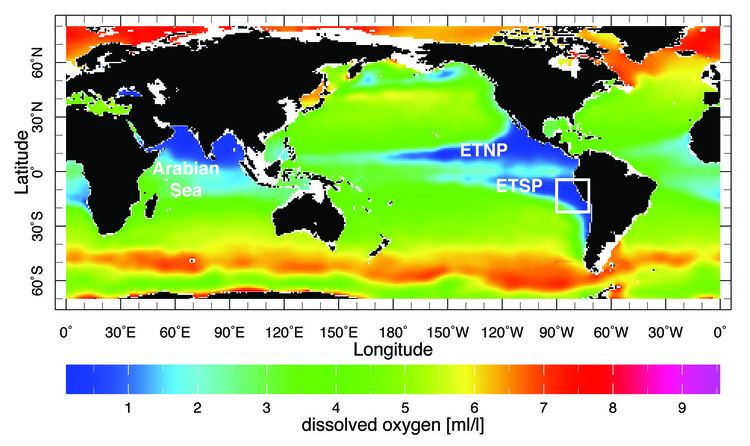 | ||
Marine life in oxygen minimum zones
The Oxygen minimum zone (OMZ), sometimes referred to as the shadow zone, is the zone in which oxygen saturation in seawater in the ocean is at its lowest. This zone occurs at depths of about 200 to 1,000 meters, depending on local circumstances. OMZs are found world-wide, typically along the western coast of continents, in areas where an interplay of physical and biological processes concurrently lower the oxygen concentration (biological processes) and restrict the water from mixing with surrounding waters (physical processes), creating a “pool” of water where oxygen concentrations fall from the normal range of 4 – 6 mg/l to below 2 mg/l.
Contents
- Marine life in oxygen minimum zones
- Reu at bios oxygen minimum zone
- Physical and Biological Processes
- Life in the OMZ
- References

Reu at bios oxygen minimum zone
Physical and Biological Processes

Surface ocean waters generally have oxygen concentrations close to equilibrium with the Earth's atmosphere. In general, colder waters hold more oxygen than warmer waters. As water moves out of the mixed layer into the thermocline it is exposed to a rain of organic matter from above. Aerobic bacteria feed on this organic matter; oxygen is used as part of the bacterial metabolic process lowering its concentration within the water. Therefore, the concentration of oxygen in deep water is dependent on the amount of oxygen it had when it was at the surface minus depletion by deep sea organisms.

The downward flux of organic matter decreases sharply with depth, with 80-90% being consumed in the top 1000m. The deep ocean thus has higher oxygen because rates of oxygen consumption are low compared with the supply of cold, oxygen-rich deep waters from polar regions. In the surface layers, oxygen is supplied by exchange with the atmosphere. Depths in between, however, have higher rates of oxygen consumption and lower rates of advective supply of oxygen-rich waters. In much of the ocean, mixing processes enable the resupply of oxygen to these waters (i.e. waters that are part of the wind-driven subtropical gyre circulations are rapidly exchanged with the surface and never acquire a strong oxygen deficit.)

The distribution of the open-ocean oxygen minimum zones is controlled by the large-scale ocean circulation as well as local physical as well as biological processes. For example, wind blowing parallel to the coast causes Ekman transport that upwells nutrients from deep water. The increased nutrients support phytoplankton blooms, zooplankton grazing, and an overall productive food web at the surface. The byproducts of these blooms and the subsequent grazing sink in the form of particulate and dissolved nutrients (from phytodetritus, dead organisms, fecal pellets, excretions, shed shells, scales, and other parts). This “rain” of organic matter (see the biological pump) feeds the microbial loop and may lead to bacterial blooms in water below the euphotic zone due to the influx of nutrients. Since oxygen is not being produced as a byproduct of photosynthesis below the euphotic zone, these microbes use up what oxygen is in the water as they break down the falling organic matter thus creating the lower oxygen conditions.

Physical processes then constrain the mixing and isolate this low oxygen water from outside water. Vertical mixing is constrained due to the separation from the mixed layer by depth. Horizontal mixing is constrained by bathymetry and boundaries formed by interactions with sub-tropical gyres and other major current systems. Low oxygen water may spread (by advection) from under areas of high productivity up to these physical boundaries to create a stagnant pool of water with no direct connection to the ocean surface even though (as in the Eastern Tropical North Pacific) there may be relatively little organic matter falling from the surface.
Life in the OMZ

Despite the low oxygen conditions, organisms have evolved to live in and around OMZs. For those organisms, like the vampire squid, special adaptations are needed to either make do with lesser amounts of oxygen or to extract oxygen from the water more efficiently. For example, the giant red mysid (Gnathophausia ingens) continues to live aerobically (using oxygen) in OMZs. They have highly developed gills with large surface area and thin blood-to-water diffusion distance that enables effective removal of oxygen from the water (up to 90% O2 removal from inhaled water) and an efficient circulatory system with high capacity and high blood concentration of a protein (hemocyanin) that readily binds oxygen.
Another strategy used by some classes of bacteria in the oxygen minimum zones is to use nitrate rather than oxygen, thus drawing down the concentrations of this important nutrient. This process is called denitrification. The oxygen minimum zones thus play an important role in regulating the productivity and ecological community structure of the global ocean. For example, giant bacterial mats floating in the oxygen minimum zone off the west coast of South America may play a key role in the region's extremely rich fisheries as bacterial mats the size of Uruguay have been found there. Existing Earth System Models project considerable reductions in oxygen and other physico-chemical variables in the ocean due to ongoing climate change, with potential ramifications for ecosystems and people.
